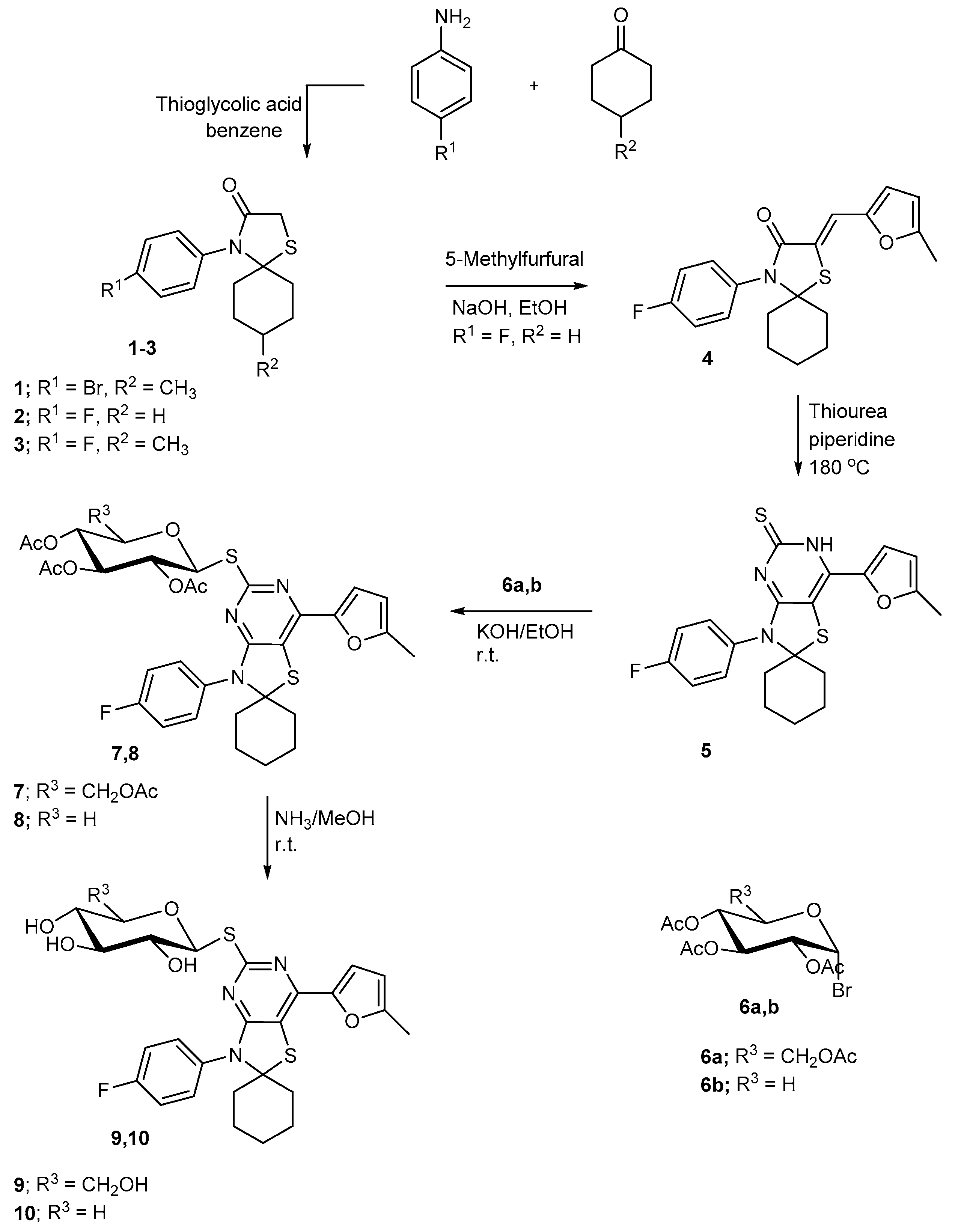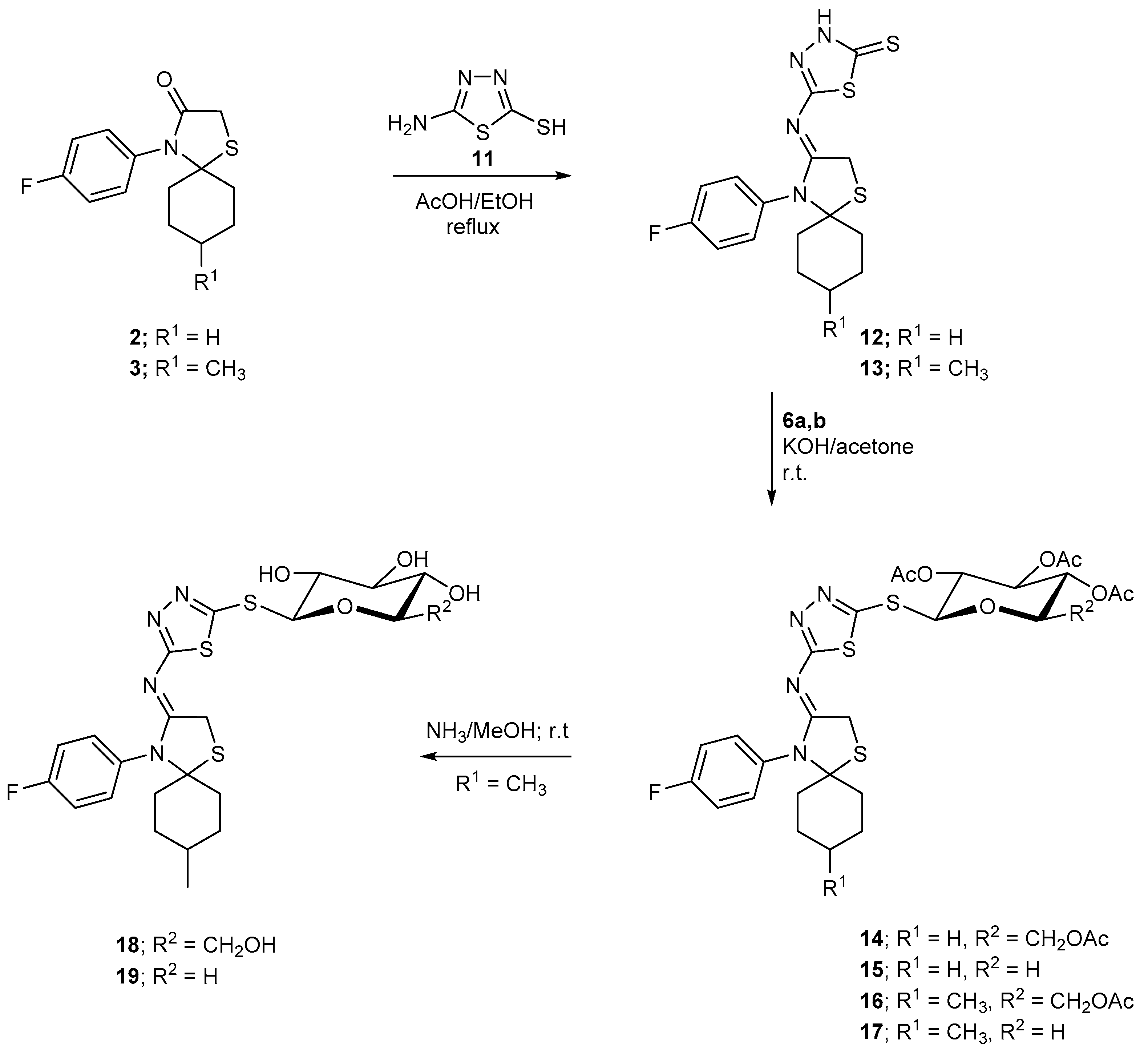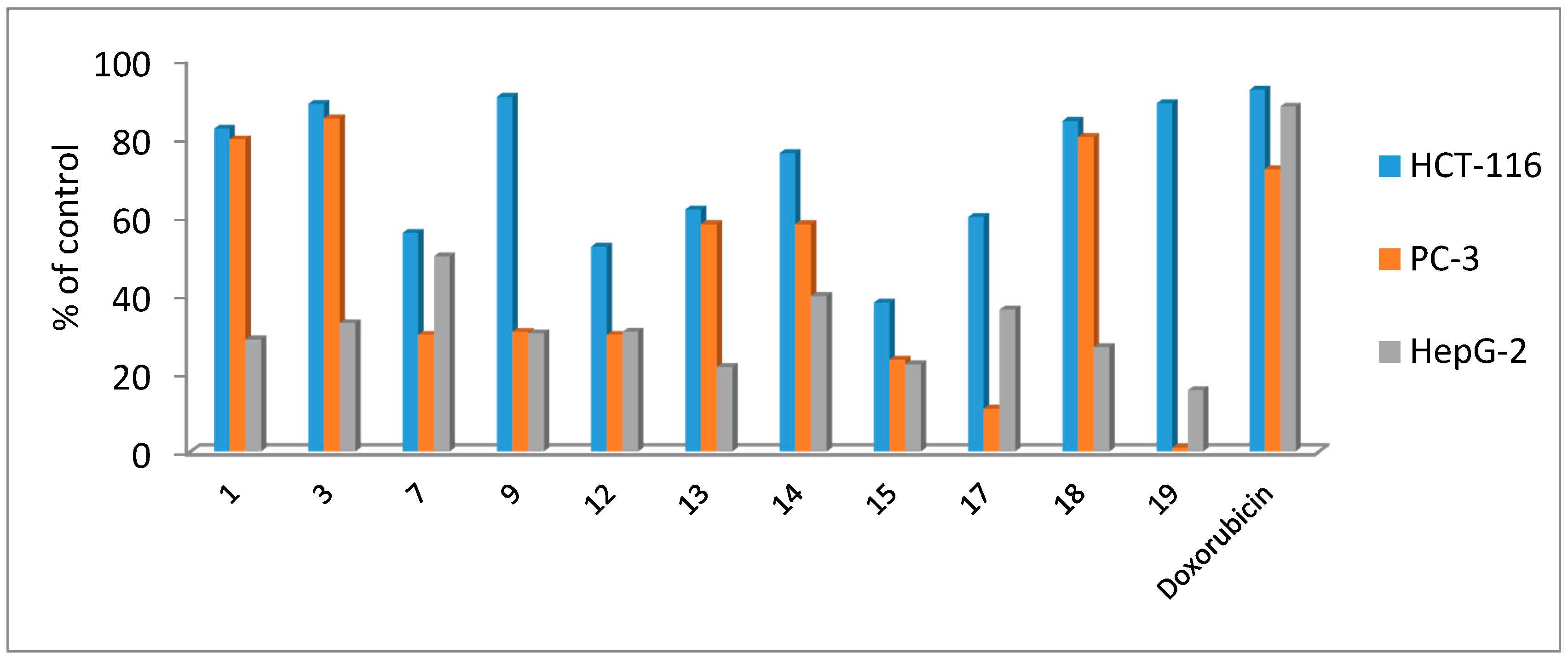Synthesis and Anticancer Activity of New 1-Thia-4-azaspiro[4.5]decane, Their Derived Thiazolopyrimidine and 1,3,4-Thiadiazole Thioglycosides
Abstract
:1. Introduction
2. Results and Discussion
2.1. Chemistry
2.2. Anti-Tumor Activity
3. Materials and Methods
3.1. Chemistry
3.1.1. 8-Substituted-4-aryl-1-thia-4-azaspiro[4.5]decan-3-one (1–3)
3.1.2. 4-(4-Fluorophenyl)-2-((5-methylfuran-2-yl)methylene)-1-thia-4-azaspiro[4.5]decan-3-one (4)
3.1.3. 3′-(4-Fluorophenyl)-7′-(5-methylfuran-2-yl)-3′H-spiro[cyclohexane-1,2′-thiazolo[4,5-d]pyrimidine]-5′(6′H)-thione (5)
3.1.4. 3′-(4-Fluorophenyl)-7′-(5-methylfuran-2-yl)-5′-(O-acetyl-d-glycopyranosyl)-3′H-spiro[cyclohexane-1,2′-thiazolo[4,5-d]pyrimidine] (7,8)
3.1.5. 3′-(4-Fluorophenyl)-7′-(5-methylfuran-2-yl)-5′-(d-glycopyranosyl)-3′H-spiro[cyclohexane-1,2′-thiazolo[4,5-d]pyrimidine] (9,10)
3.1.6. Synthesis of Aryl 1-Thia-4-azaspiro[4.5]decan-3-ylidene)amino)-1,3,4-thiadiazole-2-thiol (12,13)
3.1.7. Synthesis of N-(5-(Acetylated sugar)-1,3,4-thiadiazol-2-yl)-4-(4-fluorophenyl)-1-thia-4-azaspiro[4.5]decan-3-imine (14–17)
3.1.8. 4-(4-Fluorophenyl)-N-(5-(d-glycopyranosyl)-1,3,4-thiadiazol-2-yl)-8-methyl-1-thia-4-azaspiro[4.5]decan-3-imine (18,19)
3.2. Anticancer Screening
3.2.1. Cells
3.2.2. MTT Cytotoxicity Assay
3.2.3. Statistical Analysis
4. Conclusions
Acknowledgments
Author Contributions
Conflicts of Interest
References
- De Martino, J.K.; Boger, D.L. Glycinamide ribonucleotide transformylase (GAR TFase) as a target for cancer therapy. Drug Future 2008, 33, 969–979. [Google Scholar] [CrossRef]
- Curran, W.J. New chemotherapeutic agents: Update of major chemoradiation trials in solid tumors. Oncology 2002, 63, 29–38. [Google Scholar] [CrossRef] [PubMed]
- El-Sayed, W.A.; Abd El-Monem, Y.A.; Yousif, N.M.; Tawfek, N.; Shaaban, M.T.; Abdel Rahman, A.A.-H. Antimicrobial Activity of New 2,4-Disubstituted Thiazolidinone Derivatives. Z. Naturforsch. 2009, 64C, 785–790. [Google Scholar] [CrossRef]
- Mishra, R.; Tomar, I.; Singhal, S.; Jha, K.K. Facile synthesis of thiazolidinones bearing thiophene nucleus as antimicrobial agents. Der. Pharm. Chem. 2012, 4, 489–496. [Google Scholar]
- Patela, D.; Patela, R.; Kumaria, P.; Patelb, N.B. Synthesis of s-triazine-based thiazolidinones as antimicrobial agents. Z. Naturforsch. 2012, 67c, 108–122. [Google Scholar] [CrossRef]
- Abhinit, M.; Ghodke, M.; Pratima, N.A. Exploring potential of 4-thiazolidinone: A brief review. Int. J. Pharm. Pharm. Sci. 2009, 1, 47–64. [Google Scholar]
- Balzarini, J.; Orzeszko, B.; Maurin, J.K.; Orzeszko, A. Synthesis and anti-HIV studies of 2-adamantyl-substituted thiazolidin-4-ones. Eur. J. Med. Chem. 2007, 42, 993–1003. [Google Scholar] [CrossRef] [PubMed]
- Li, W.; Lu, Y.; Wang, Z.; Dalton, J.T.; Miller, D.D. Synthesis and antiproliferative activity of thiazolidine analogs for melanoma. Bioorg. Med. Chem. Lett. 2007, 17, 4113–4117. [Google Scholar] [CrossRef] [PubMed]
- Chandrappa, S.; Benaka Prasad, S.B.; Vinaya, K.; Ananda Kumar, C.S.; Thimmegowda, N.R.; Rangappa, K.S. Synthesis and in vitro antiproliferative activity against human cancer cell lines o novel 5-(4-methyl-benzylidene)-thiazolidine-2,4-diones. Investig. New Drugs 2008, 26, 437–444. [Google Scholar] [CrossRef] [PubMed]
- Anh, H.L.T.; Cuc, N.T.; Tai, B.H.; Yen, P.H.; Nhiem, N.X.; Thao, D.T.; Na, N.H.; Minh, C.V.; Kiem, P.V.; Kim, Y.H. Synthesis of Chromonylthiazolidines and Their Cytotoxicity to Human Cancer Cell Lines. Molecules 2015, 20, 1151–1160. [Google Scholar] [CrossRef] [PubMed]
- Joshi, H.; Pal, T.; Ramaa, C.S. A new dawn for the use of thiazolidinediones in cancer therapy. Expert Opin. Investig. Drugs 2014, 23, 501–510. [Google Scholar] [CrossRef] [PubMed]
- Blanquicett, C.; Roman, J.; Hart, C.M. Thiazolidinediones as anti-cancer agents. Cancer Ther. 2008, 6, 25–34. [Google Scholar] [PubMed]
- Chen, X.; Chong, C.R.; Shi, L.; Yoshimoto, T.; Sullivan, D.J.; Liu, J.O. Inhibitors of Plasmodium falciparum methionine aminopeptidase 1b possess antimalarial activity. Proc. Natl. Acad. Sci. USA 2006, 103, 14548–14553. [Google Scholar] [CrossRef] [PubMed]
- Flefel, E.M.; Sayed, H.H.; Hashem, A.I.; Shalaby, E.A.; El-Sofany, W.; Abdel-Megeid, F.M.E. Pharmacological evaluation of some novel synthesized compounds derived from spiro(cyclohexane-1,20-thiazolidines). Med. Chem. Res. 2014, 23, 2515–2527. [Google Scholar] [CrossRef]
- Amr, A.-E.-G.; Maigali, S.S.; Abdulla, M.M. Synthesis, and analgesic and antiparkinsonian activities of thiopyrimidine, pyrane, pyrazoline, and thiazolopyrimidine derivatives from 2-chloro-6-ethoxy-4-acetylpyridine. Monatsh. Chem. 2008, 139, 1409–1415. [Google Scholar] [CrossRef]
- Branstetter, B.J.; Breitenbucher, J.G.; Lebsack, A.D.; Xiao, W. Thiazolopyrimidine Modulators of TRPV1. U.S. Patent WO 005303, 10 January 2008. [Google Scholar]
- Mohamed, A.M.; Amr, A.E.G.; Alsharari, M.A.; Al-Qalawi, H.R.M.; Germoush, M.O.; Al-Omar, M.A. Anticancer Activities of Some New Synthesized Thiazolo[3,2-a]Pyrido[4,3-d]Pyrimidine Derivatives. Am. J. Biochem. Biotechnol. 2011, 7, 43–54. [Google Scholar] [CrossRef]
- Hammam, A.G.; El-Salam, O.I.A.; Mohamed, A.M.; Hafez, N.A. Novel fluoro substituted benzo[o]pyranwith anti-lung cancer activity. Ind. J. Chem. 2005, 44B, 1887–1893. [Google Scholar]
- Flefel, E.E.; Salama, M.A.; El-Shahat, M.; El-Hashash, M.A.; El-Farargy, A.F. A novel synthesis of some new pyrimidine and thiazolopyrimidine derivatives for anticancer evaluation. Phosphorus Sulfur Silicon Relat. Elem. 2007, 182, 1739–1756. [Google Scholar] [CrossRef]
- Youssef, M.M.; Amin, M.A. Microwave Assisted Synthesis of Some New Thiazolopyrimidine, Thiazolodipyrimidine and Thiazolopyrimidothiazolopyrimidine Derivatives with Potential Antioxidant and Antimicrobial Activity. Molecules 2012, 17, 9652–9667. [Google Scholar] [CrossRef] [PubMed]
- Said, M.; Abouzid, K.; Mouneer, A.; Ahmedy, A.; Osman, A.-M. Synthesis and biological evaluation of new thiazolopyrimidines. Arch. Pharm. Res. 2004, 27, 471–477. [Google Scholar] [CrossRef] [PubMed]
- Linder, W.; Brandes, W. Pesticidal Thiazolopyrimidine Derivatives. U.S. Patent 4996208, 26 February 1991. [Google Scholar]
- Duval, R.; Kolb, S.; Braud, E.; Genest, D.; Garbay, C. Rapid discovery of triazolobenzylidenethiazolopyrimidines (TBTP) as CDC25 phosphatase inhibitors by parallel click chemistry and in situ screening. J. Comb. Chem. 2009, 11, 947–950. [Google Scholar] [CrossRef] [PubMed]
- Kolb, S.; Mondésert, O.; Goddard, M.L.; Jullien, D.; Villoutreix, B.O.; Ducommun, B.; Garbay, C.; Braud, E. Development of novel thiazolopyrimidines as CDC25B phosphatase inhibitors. ChemMedChem 2009, 4, 633–648. [Google Scholar] [CrossRef] [PubMed]
- Zhi, H.; Chen, L.; Zhang, L.; Liu, S.; Wan, D.C.C.; Lin, H.; Hu, C. Design, synthesis, and biological evaluation of 5H-thiazolo[3,2-a]pyrimidine derivatives as a new type of acetylcholinesterase inhibitors. ARKIVOC 2008, xiii, 266–277. [Google Scholar]
- Rashad, A.E.; Shamroukh, A.H.; Abdel-Megeid, R.E.; El-Sayed, W.A. Synthesis, reactions and antimicrobial evaluation of some polycondensedthieno-pyrimidine derivatives. Synth. Commun. 2010, 40, 1149–1160. [Google Scholar] [CrossRef]
- El-Emary, T.I.; Abdel-Mohsen, S.A. Synthesis and antimicrobial activity of some new 1,3-diphenylpyrazoles bearing pyrimidine, Pyrimidinethione, thiazolopyrimidine, triazolopyrimidine, thio- and alkylthiotriazolopyrimidinone moieties at the 4-position. Phosphorus Sulfur 2006, 181, 2459–2474. [Google Scholar] [CrossRef]
- Maddila, S.; Damu, G.L.V.; Oseghe, E.O.; Abafe, O.A.; Venakata, R.C.; Lavanya, P. Synthesis and biological studies of novel biphenyl-3,5-dihydro-2H-thiazolo-pyrimidines derivatives. J. Korean Chem. Soc. 2012, 56, 334–340. [Google Scholar] [CrossRef]
- Fahmy, H.T.Y.; Rostom, S.A.F.; Saudi, M.N.; Zjawiony, J.K.; Robins, D.J. Synthesis and in vitro evaluation of the anticancer activity of novel fluorinated thiazolo[4,5-d]pyrimidines. Arch. Pharm. Pharm. Med. Chem. 2003, 336, 216–225. [Google Scholar] [CrossRef] [PubMed]
- Dawood, K.M.; Gomha, S.M. Synthesis and Anti-cancer Activity of 1,3,4-Thiadiazole and 1,3-Thiazole Derivatives Having 1,3,4-Oxadiazole Moiety. J. Heterocycl. Chem. 2015, 52, 1400–1405. [Google Scholar] [CrossRef]
- Blanc-Muesser, M.; Vigne, L.; Driguez, H.; Lehmann, J.; Steck, J.; Urbahns, K. Spacer-modified disaccharide and pseudo trisaccharide methyl glycosides that mimic maltotriose, as competitive inhibitors for pancreatic alpha-amylase: A demonstration of the “clustering effect”. Carbohydr. Res. 1992, 224, 59–71. [Google Scholar] [CrossRef]
- El Ashry, E.S.H.; Awad, L.F.; Atta, I.A. Synthesis and role of glycosylthio heterocycles in carbohydrate chemistry. Tetrahedron 2006, 62, 2943–2998. [Google Scholar] [CrossRef]
- El-Sayed, W.A.; Abbas, H.S.; Abdel Magid, R.E.; Magdziarz, T. Synthesis, Antimicrobial Activity and Docking Studies of New 3-(Pyrimidin-4-yl)-1H-indole Derivatives and Their Derived N- and S-glycoside Analogs. Med. Chem. Res. 2016, 25, 339–355. [Google Scholar] [CrossRef]
- Mereyala, H.B.; Gurijala, V.R. Use of 2-pyridyl-2-acetamido-3,4,6-tri-O-acetyl-2- deoxy-1-thio-b-d-gluco-pyranoside as a glycosyl donor and methyl iodide as anactivator for the synthesis of 1,2-trans-linked saccharides. Carbohydr. Res. 1993, 242, 277–280. [Google Scholar] [CrossRef]
- Abbas, H.S.; El-Sayed, W.A.; Fathy, N.M. Synthesis and antitumor activity of new dihydropyridine thioglycosides and their corresponding dehydrogenated forms. Eur. J. Med. Chem. 2010, 45, 973–982. [Google Scholar] [CrossRef] [PubMed]
- Mohamed, A.M.; El-Sayed, W.A.; Al-Qallawi, H.R.M.; Germoush, M.O. Synthesis and antimicrobial activity of New Norbornyl system based Oxadiazole Thioglycosides and Acyclic Nucleoside Analogs. Acta Pol. Pharm. Drug Res. 2014, 71, 771–780. [Google Scholar]
- Mohamed, A.M.; Al-Qallawi, H.R.M.; El-Sayed, W.A.; Arafa, W.A.A.; Alhumaimus, M.S.; Hassan, A.K. Anticancer Activity of Newly Synthesized Triazolopyrimidine Derivatives and Their Nucleoside Analogs. Acta Pol. Pharm. Drug Res. 2015, 72, 307–318. [Google Scholar]
- El-Sayed, W.A.; Fathi, N.M.; Gad, W.A.; El-Ashry, E.S.H. Synthesis, and Antiviral Evaluation of Some 5-N-Arylaminomethyl-2-glycosylsulphanyl-1,3,4-oxadiazoles and their analogues against Hepatitis A and Herpes simplex viruses. J. Carbohydr. Chem. 2008, 27, 357–372. [Google Scholar] [CrossRef]
- Ibrahim, Y.A.; Abbas, A.A.; Elwahy, A.H.M. Selective synthesis and structure of 2-N- and 3-S-glucosyl-1,2,4-triazoles of potential biological interest. Carbohydr. Lett. 1999, 3, 331–338. [Google Scholar]
- Mansour, A.K.; Ibrahim, Y.A.; Khalil, N.S.A.M. Selective synthesis and structure of 6-arylvinyl-2- and 4-glucosyl-1,2,4-triazines of expected interesting biological activity. Nucleosides Nucleotides Nucleic Acids 1999, 18, 2256–2283. [Google Scholar] [CrossRef]
- Salih, N.A. Synthesis and Characterization of Novel Azole Heterocycles Based on 2,5-Disubstituted Thiadiazole. Turk. J. Chem. 2008, 32, 229–235. [Google Scholar]
- Yusuf, M.; Khan, R.A.; Ahmed, B. Syntheses and anti-depressant activity of 5-amino-1,3,4-thiadiazole-2-thiol imines and thiobenzyl derivatives. Bioorg. Med. Chem. 2008, 16, 8029–8034. [Google Scholar] [CrossRef] [PubMed]
- Hu, Y.; Li, C.-Y.; Wang, X.-M.; Yang, Y.-H.; Zhu, H.-L. 1,3,4-Thiadiazole: Synthesis, Reactions, and Applications in Medicinal, Agricultural, and Materials Chemistry. Chem. Rev. 2014, 114, 5583–5584. [Google Scholar] [CrossRef] [PubMed]
- Hamdy, N.A.; Anwar, M.M.; Abu-Zied, K.M.; Awad, H.M. Synthesis, tumor inhibitory and antioxidant activity of new polyfunctionally 2-substituted 5,6,7,8-tetrahydronaphthalene derivatives containing pyridine, thioxopyridine and pyrazolopyridine moieties. Acta. Pol. Pharm. Drug Res. 2013, 70, 987–1001. [Google Scholar]
- Soliman, H.A.; Yousif, M.N.M.; Said, M.M.; Hassan, N.A.; Ali, M.M.; Awad, H.M.; Abdel-Megeid, F.M.E. Synthesis of novel 1,6-naphthyridines, pyrano[3,2-c]pyridines and pyrido[4,3-d]pyrimidines derived from 2,2,6,6-tetramethylpiperidin-4-one for in vitro anticancer and antioxidant evaluation. Der. Pharma. Chem. 2014, 6, 394–410. [Google Scholar]
- Awad, H.M.; Abd-Alla, H.I.; Mahmoud, K.H.; El-Toumy, S.A. In vitro anti-nitrosative, antioxidant, and cytotoxicity activities of plant flavonoids: A comparative study. Med. Chem. Res. 2014, 23, 3298–3307. [Google Scholar] [CrossRef]
- Sample Availability: Samples of the compounds are available from the authors.




| Compound | HCT-116 | PC-3 | HepG-2 |
|---|---|---|---|
| IC50 (nM) ± SD | |||
| 1 | 178.1 ± 5.3 | 184.1 ± 6.3 | 509.5 ± 9.2 |
| 3 | 201.3 ± 3.8 | 210.2 ± 4.7 | 541.4 ± 7.2 |
| 7 | 120.1 ± 4.1 | 223.9 ± 6.4 | 134.5 ± 4.9 |
| 9 | 95.8 ± 3.7 | 281.8 ±3.6 | 285.1 ± 3.9 |
| 12 | 250.3 ± 5.7 | 437.4 ± 5.3 | 425.6 ± 8.6 |
| 13 | 204.6 ± 3.8 | 217.7 ± 8.1 | 581.5 ± 9.3 |
| 14 | 92.2 ± 1.8 | 120.8 ± 3.9 | 176.1 ± 2.9 |
| 15 | 204.6 ± 3.5 | 331.3 ± 9.2 | 348.5 ± 7.4 |
| 17 | 127.4 ± 5.6 | 693.9 ± 8.9 | 209.7 ± 10.1 |
| 18 | 106.3 ± 2.9 | 111.6 ± 3.8 | 334.1 ± 9.9 |
| 19 | 106.6 ± 4.2 | 9493.8 ± 20.9 | 599.0 ± 11.5 |
| Doxorubicin | 126.7 ± 8.9 | 129.7 ± 2.4 | 117.1 ± 5.8 |
© 2017 by the authors. Licensee MDPI, Basel, Switzerland. This article is an open access article distributed under the terms and conditions of the Creative Commons Attribution (CC BY) license ( http://creativecommons.org/licenses/by/4.0/).
Share and Cite
Flefel, E.M.; El-Sayed, W.A.; Mohamed, A.M.; El-Sofany, W.I.; Awad, H.M. Synthesis and Anticancer Activity of New 1-Thia-4-azaspiro[4.5]decane, Their Derived Thiazolopyrimidine and 1,3,4-Thiadiazole Thioglycosides. Molecules 2017, 22, 170. https://doi.org/10.3390/molecules22010170
Flefel EM, El-Sayed WA, Mohamed AM, El-Sofany WI, Awad HM. Synthesis and Anticancer Activity of New 1-Thia-4-azaspiro[4.5]decane, Their Derived Thiazolopyrimidine and 1,3,4-Thiadiazole Thioglycosides. Molecules. 2017; 22(1):170. https://doi.org/10.3390/molecules22010170
Chicago/Turabian StyleFlefel, Eman M., Wael A. El-Sayed, Ashraf M. Mohamed, Walaa I. El-Sofany, and Hanem M. Awad. 2017. "Synthesis and Anticancer Activity of New 1-Thia-4-azaspiro[4.5]decane, Their Derived Thiazolopyrimidine and 1,3,4-Thiadiazole Thioglycosides" Molecules 22, no. 1: 170. https://doi.org/10.3390/molecules22010170
APA StyleFlefel, E. M., El-Sayed, W. A., Mohamed, A. M., El-Sofany, W. I., & Awad, H. M. (2017). Synthesis and Anticancer Activity of New 1-Thia-4-azaspiro[4.5]decane, Their Derived Thiazolopyrimidine and 1,3,4-Thiadiazole Thioglycosides. Molecules, 22(1), 170. https://doi.org/10.3390/molecules22010170






